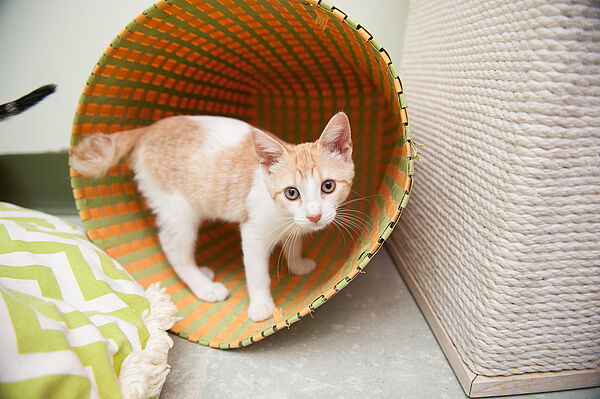Just like for humans, the five senses play an important role in helping felines understand their surroundings. But the way cats use those senses is often very different than how we do.
Smell
A cat’s sense of smell is the primary way he identifies people and objects. Cats have more than 200 million odor sensors in their noses; humans have just 5 million. Their sense of smell is 14 times better than that of humans. Because their sense of smell is so sensitive, it’s important to be aware of things like scented litter, other animal’s smells on you or an unfamiliar scent in your cat’s environment (such as a new piece of furniture or a house guest). These things may upset your feline friend.
Taste
A cat’s sense of taste is weak. Humans have 9,000 taste buds. Cats have 473. They make up for this deficiency with a superior sense of smell. Their most powerful response to food is through smell, not taste.
Touch
From birth, touch is a primary source of affection for cats. They will groom each other and lay against one another from a very young age. Cats will often behave like kittens and start drooling or kneading when they are stroked. Each hair has many nerve endings and evokes a very clear response from the nervous system. Their heart rate slows, their muscles loosen and their body relaxes.
The more contact you have with a cat when he is young, the more likely he will enjoy human contact when older. Still, cats vary in how much they like to be pet or held. They will let you know when they have had enough. Cats who do not enjoy prolonged petting or being held will still play with their owners, follow them around the house, sleep on the bed with them, and even sit on laps.
Whiskers are extensions of the cat’s skin and are designed to detect even the smallest changes in the environment, including air currents, air pressure, temperature and wind direction. They are embedded three times as deep as fur and translate the slightest contact to sensory cells at their roots. They help cats navigate at night by acting like radar. They also stimulate an eye blink when touched, which protects their eyes.
Sight
A cat’s visual activity is 10 times less than that of a human. To compensate, the structure of the retina provides him with movement detectors to help locate prey. The location of a cat’s eyes on the front of the face enables him to calculate the exact distance he has to leap to catch his prey. The tapetum, a reflective layer at the back of the eye, increases the amount of light that passes through the retina and enables the cat to see well in low-intensity light. But cats can’t see any better than humans in total darkness.
Hearing
The cat’s outer ear is connected by 27 muscles. It can rotate 180 degrees to scan the environment or to direct attention to a particular sound. Cats can detect higher frequencies than dogs. Cats can also determine where the sound is coming from by sensing differences in the time of the arrival and the intensity of the sound received by the two ears.

